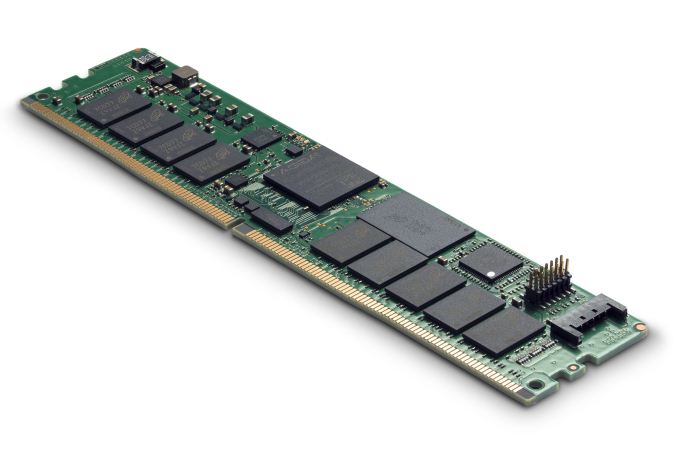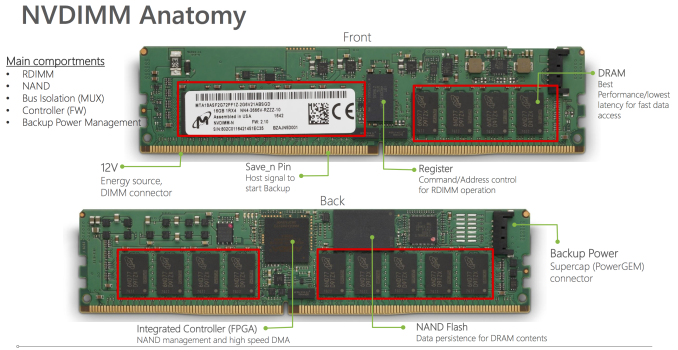Micron Announces 32GB DDR4 NVDIMM-N Modules
by Billy Tallis on November 13, 2017 9:00 AM EST
Micron is announcing today their next generation of NVDIMM-N modules combining DDR4 DRAM with NAND flash memory to support persistent memory usage models. The new 32GB modules double the capacity of Micron's previous NVDIMMs and boost the speed rating to DDR4-2933 CL21, faster than what current server platforms support.
Micron is not new to the Non-Volatile DIMM market: their first DDR3 NVDIMMs predated JEDEC standardization. The new 32GB modules were preceded by 8GB and 16GB DDR4 NVDIMMs. Micron's NVDIMMs are type N, meaning they function as ordinary ECC DRAM DIMMs but have NAND flash to backup data to in the event of a power loss. This is in contrast to the NVDIMM-F type that offers pure flash storage. During normal system operation, Micron's NVDIMMs use only the DRAM. When the system experiences a power failure or signals that one is imminent, the module's onboard FPGA-based takes over to manage saving the contents of the DRAM to the module's 64GB of SLC NAND flash. During a power failure, the module can be powered either through a cable to an external AGIGA PowerGEM capacitor module, or by battery backup supplied through the DIMM slot's 12V pins.
Micron says the most common use cases for their NVDIMMs are for high-performance journalling and log storage for databases and filesystems. In these applications, a 2S server will typically be equipped with a total of about 64GB of NVDIMMs, so the new Micron 32GB modules allow these systems to use just a single NVDIMM per CPU, leaving more slots free for traditional RDIMMs. Both operating systems and applications need special support for persistent memory provided by NVDIMMs: the OS to handle restoring saved state after a power failure, and applications to manage what portions of their memory should be allocated from the persistent portion of the overall memory pool. This can be addressed either through applications using block storage APIs to access the NVDIMM's memory, or through direct memory mapping.
Micron is currently sampling the new 32GB NVDIMMs but did not state when they will be available in volume.
Conspicuously absent from Micron's announcement today is any mention of the third kind of memory they make: 3D XPoint non-volatile memory. Micron will eventually be putting 3D XPoint memory onto DIMMs and into SSDs under their QuantX brand, but so far they have been lagging far behind Intel in announcing and shipping specific products. NVDIMMs based on 3D XPoint memory may not match the performance of DRAM modules or these NVDIMM-N modules, but they will offer higher storage density at a much lower cost and without the hassle of external batteries or capacitor banks. Until those are ready, Micron is smart to nurture the NVDIMM ecosystem with their DRAM+flash solutions.
Source: Micron











48 Comments
View All Comments
ddriver - Monday, November 13, 2017 - link
Yeah that will be a blast - much slower than ram, but at least it wears out, so that's gotta make up for the abysmal performance. Replacing worn out dimm modules periodically - that does wonders to reduce downtime hehehe.PeachNCream - Monday, November 13, 2017 - link
(>^^)> <3 <(^^<)theniller - Monday, November 13, 2017 - link
here I must agree with DDriver! This is why normal people use an UPS! Anyone with an important server have one thus makes this useless.ddriver - Monday, November 13, 2017 - link
Pretty much yes - even winblows can hybernate - dump and restore paged memory, resuming a powered off system to its previous state. You only need a few seconds of battery backup on a decent system. Even the most basic UPS has enough juice for that.And data centers go further, they have UPS as well as power generators. Those are pretty affordable to "normal people" too, I got a 5 KW gasoline generator for like 300 bucks for critical electronics and the security system, lasts 10 hours on a single fuel tank, and you can always top it off while it is running.
Elstar - Monday, November 13, 2017 - link
Don't confuse having a UPS with a backup plan. These NVDIMMs represent the fastest backup and restore in the event of a total (including UPS) power failure.ddriver - Monday, November 13, 2017 - link
You are the one confusing how quickly this works. The only advantage it has is relying on a dedicated power source and on-board implementation, you can lose an UPS or even a PSU and it may still manage to backup the data, possibly even after the rest of the system has lost power.That being said, this benefit is very diminished, since proper servers have redundancy both at UPS and PSU level. And if you somehow lose all that, those NVDIMMs won't be that much of a win in terms of reducing downtime.
Reflex - Monday, November 13, 2017 - link
I've seen a server room lose everything. One upstairs from my own lab actually. Malfunctioning component set off the sprinkler system. Due to some failures in the fire suppression system the server room was filled with 3ft of water overnight, and additional failures caused a lack of notification until the next morning.I don't care how redundant you are, more redundancy is a good thing in certain spaces. In that case it literally knocked the team in question out of an entire industry as the data in that lab was too large to have replicated elsewhere (this was pre-cloud, back in 2007 or so). Redundant UPS's couldn't do a damn thing about the sudden loss of power. And while this specific solution would probably not have saved them, the point is that every redundant system can potentially fail which is why you do layered disaster recovery and NEVER rely on one thing, or even two or three.
Furthermore, you should routinely exercise disaster scenarios to ensure you do not have an unanticipated weak link.
Yes, mission critical servers and data storage should have redundant UPS's, I'd argue at more levels than just the room itself. Yes they should have offsite backups and failover regions. Obviously the storage itself should be redundant. There is nothing wrong with also making the memory capable of surviving failure also. Quite frankly in the space this is targeted at, it's just money and if you can solve a problem with money that is the easiest solution available.
diehardmacfan - Tuesday, November 14, 2017 - link
NVDIMM's are commonly used in the SAN space. Nimble uses them to cache all incoming writes, and some are now using them with ZFS as a dedicated ZIL. Having seconds of incoming writes getting hosed because you had some massive kernel panic can wreak having on a filesystem. NAND is currently not fast enough when it comes to latency and max throughput at low queue depths. There are some other solutions that could be useful (Optane.. etc) but there are drawbacks to all of them.Why you refuse to see the usefulness of this product is beyond me.